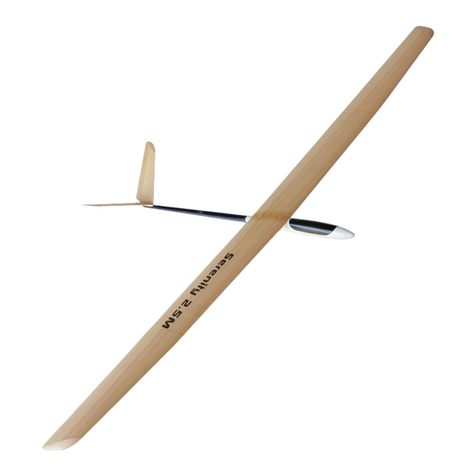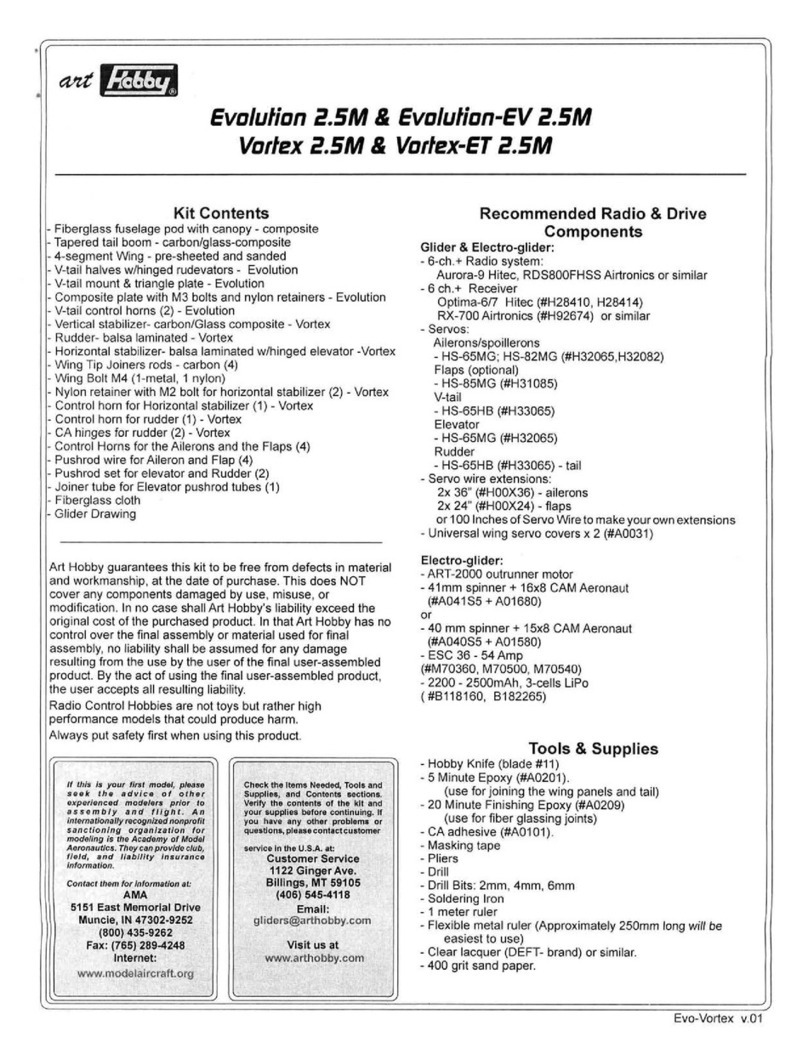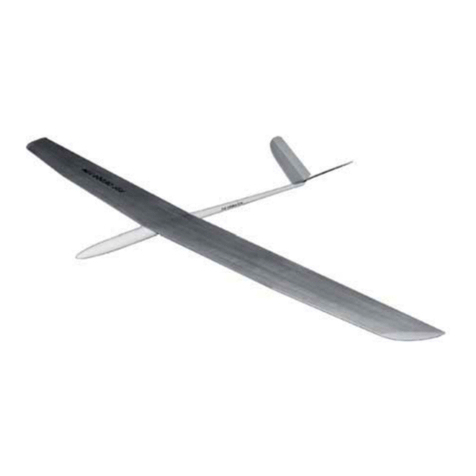
2
Recommended Building Steps
Attention: The ailerons should remain uncut from the wing
as long as possible. Meaning after wing is finished and
painted it should be put aside to cure. The paint curing process
and reacting with the wood usually takes 2-3 days even in a
warm environment. During this time all surfaces should remain
uncut. (many times modelers are impatient and cut the
ailerons/flaps as soon as the wing is dry to the touch)
If the control surfaces are cut from wing shortly after it’s painted
then more likely will be distorted while paint curing.
We recommend to start building the glider from the wing:
1. finish both wing tips
2. cut and box wing servo bays preparing for servo installation.
3. glue together wing center panels and laminate the joint.
4. paint the wing (including personal touches) to its final stage
and put the wing aside to cure the paint (longer time is better)
5. prepare wing servo wiring and.
6. assemble the glider tail
7. assemble fuselage with tail, install push-rods and servos in
the pod. (those steps usually take 1-2 evenings - this is also
valuable time needed to cure painted wing)
8. separate ailerons from the wing.
9. install aileron servos and control horns and finis wiring.
Wing Tips
1. Remove the wing segments from their protective foam.
2. Sand the balsa wing tips to shape. Only round the top. Leave
the bottom of the tip the shape of the wing foil. Try to make the tips
match as closely as possible. Photo 1
Finishing wing Wood Surfaces
To prevent the wood from pre-mature aging and moisture
damage, we recommend sealing all wood surfaces using
lacquer manufactured by DEFT (available from ACE Hardware
stores or Lowe’s).
(Prior to using lacquer, any white foam surface should be
sealed with epoxy). The black poplar veneer wing skins
(~0.4mm thick) are sealed under surface, then laminated with
epoxy to the wing foam cores. This process is making a barrier
preventing harsh lacquer thinner penetration inside.
We recommend to apply lacquer in very light coats, this way
lacquer thinner evaporates very fast and does not have time to
cause any harm to the wing. The best finish result is achieved
by brushing 2 light coats of Lacquer Sanding Sealer then sand
surface after second coat using 400 grit sandpaper, then spray
on a very light finishing coat if desired - use as little as possible
to keep the weight down.
Color Option: After wing is completely finished with lacquer
you can mask it and spray some color stripes, especially to the
bottom side of the wing. This will give the glider some accent
and provide you with better visibility during flight, especially
high altitude thermal gliding. P. 1
Joining Wing Panels
To achieve a proper dihedral angle the root of each wing
halve is sanded at a slight angle to fit.
1. Place one of the wing halves root on the pod saddle. Mark the
bottom side root of the wing 40mm and 120mm back from the
leading edge. Also mark the position of the wing servo wire
canals on the bottom side of the wing panels roots . Photo 3
P. 3
Pod and Boom Preparation
1. Use coares sand paper and rough up paint surface on the
fuselage pod joiner tip joiner tip. Trial fit the boom with the pod
and check the alignment.
2. Drill three 2mm holes in the boom, they will be used later for
gluing pod and boom together. Photo 2
Note: Do NOT glue together pod to boom in this stage.
P. 2
Momentum-DL v.1
Notes about the finished surfaces:
The fuselage is painted (in the mold). The white paint will be
damaged by thinners. The wood surfaces can be finished with
a proper clear finish. Remember that the wing has a foam
core and some paints may attack the foam internally.






























